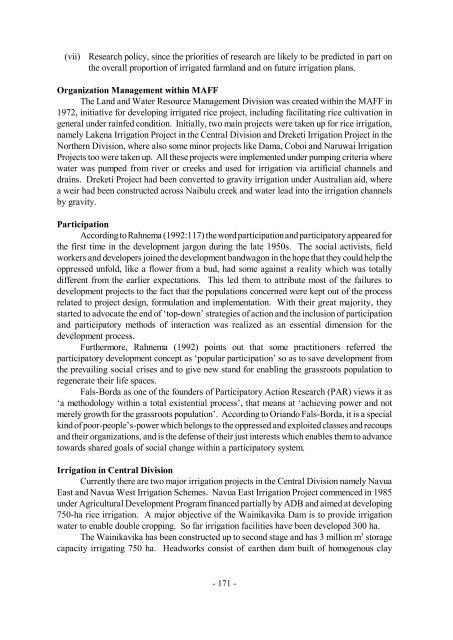Organizational Change for Participatory Irrigation Management
Organizational Change for Participatory Irrigation Management
Organizational Change for Participatory Irrigation Management
You also want an ePaper? Increase the reach of your titles
YUMPU automatically turns print PDFs into web optimized ePapers that Google loves.
(vii) Research policy, since the priorities of research are likely to be predicted in part on<br />
the overall proportion of irrigated farmland and on future irrigation plans.<br />
Organization <strong>Management</strong> within MAFF<br />
The Land and Water Resource <strong>Management</strong> Division was created within the MAFF in<br />
1972, initiative <strong>for</strong> developing irrigated rice project, including facilitating rice cultivation in<br />
general under rainfed condition. Initially, two main projects were taken up <strong>for</strong> rice irrigation,<br />
namely Lakena <strong>Irrigation</strong> Project in the Central Division and Dreketi <strong>Irrigation</strong> Project in the<br />
Northern Division, where also some minor projects like Dama, Coboi and Naruwai <strong>Irrigation</strong><br />
Projects too were taken up. All these projects were implemented under pumping criteria where<br />
water was pumped from river or creeks and used <strong>for</strong> irrigation via artificial channels and<br />
drains. Dreketi Project had been converted to gravity irrigation under Australian aid, where<br />
a weir had been constructed across Naibulu creek and water lead into the irrigation channels<br />
by gravity.<br />
Participation<br />
According to Rahnema (1992:117) the word participation and participatory appeared <strong>for</strong><br />
the first time in the development jargon during the late 1950s. The social activists, field<br />
workers and developers joined the development bandwagon in the hope that they could help the<br />
oppressed unfold, like a flower from a bud, had some against a reality which was totally<br />
different from the earlier expectations. This led them to attribute most of the failures to<br />
development projects to the fact that the populations concerned were kept out of the process<br />
related to project design, <strong>for</strong>mulation and implementation. With their great majority, they<br />
started to advocate the end of ‘top-down’ strategies of action and the inclusion of participation<br />
and participatory methods of interaction was realized as an essential dimension <strong>for</strong> the<br />
development process.<br />
Furthermore, Rahnema (1992) points out that some practitioners referred the<br />
participatory development concept as ‘popular participation’ so as to save development from<br />
the prevailing social crises and to give new stand <strong>for</strong> enabling the grassroots population to<br />
regenerate their life spaces.<br />
Fals-Borda as one of the founders of <strong>Participatory</strong> Action Research (PAR) views it as<br />
‘a methodology within a total existential process’, that means at ‘achieving power and not<br />
merely growth <strong>for</strong> the grassroots population’. According to Oriando Fals-Borda, it is a special<br />
kind of poor-people’s-power which belongs to the oppressed and exploited classes and recoups<br />
and their organizations, and is the defense of their just interests which enables them to advance<br />
towards shared goals of social change within a participatory system.<br />
<strong>Irrigation</strong> in Central Division<br />
Currently there are two major irrigation projects in the Central Division namely Navua<br />
East and Navua West <strong>Irrigation</strong> Schemes. Navua East <strong>Irrigation</strong> Project commenced in 1985<br />
under Agricultural Development Program financed partially by ADB and aimed at developing<br />
750-ha rice irrigation. A major objective of the Wainikavika Dam is to provide irrigation<br />
water to enable double cropping. So far irrigation facilities have been developed 300 ha.<br />
The Wainikavika has been constructed up to second stage and has 3 million m 3 storage<br />
capacity irrigating 750 ha. Headworks consist of earthen dam built of homogenous clay<br />
- 171 -
















